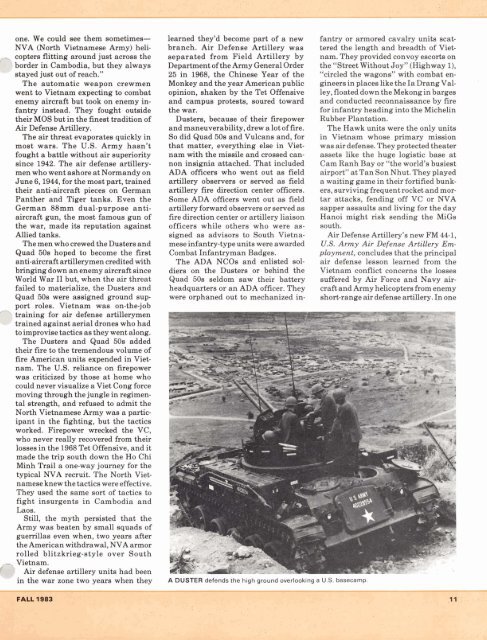Create successful ePaper yourself
Turn your PDF publications into a flip-book with our unique Google optimized e-Paper software.
one. We could see them sometimes-<br />
NVA (North Vietnamese Army) helicopters<br />
flitting around just across the<br />
1 border in Cambodia, but they always<br />
stayed just out of reach."<br />
The automatic weapon crewmen<br />
went to Vietnam expecting to combat<br />
enemy aircraft but took on enemy infantry<br />
instead. They fought outside<br />
their MOS but in the finest tradition of<br />
<strong>Air</strong> <strong>Defense</strong> <strong>Artillery</strong>.<br />
The air threat evaporates quickly in<br />
most wars. The U.S. Army hasn't<br />
fought a battle without air superiority<br />
since 1942. The air defense artillerymen<br />
who went ashore at Normandy on<br />
June 6,1944, for the most part, trained<br />
their anti-aircraft pieces on German<br />
Panther and Tiger tanks. Even the<br />
German 88mm dual-purpose antiaircraft<br />
gun, the most famous gun of<br />
the war, made its reputation against<br />
Allied tanks.<br />
The men who crewed the <strong>Dusters</strong> and<br />
Quad 50s hoped to become the first<br />
anti-aircraft artillerymen credited with<br />
bringing down an enemy aircraft since<br />
World War I1 but, when the air threat<br />
failed to materialize, the <strong>Dusters</strong> and<br />
Quad 50s were assigned ground support<br />
roles. Vietnam was on-the-job<br />
training for air defense artillerymen<br />
trained against aerial drones who had<br />
to improvise tactics as they went along.<br />
The <strong>Dusters</strong> and Quad 50s added<br />
their fire to the tremendous volume of<br />
fire American units expended in Vietnam.<br />
The U.S. reliance on firepower<br />
was criticized by those at home who<br />
could never visualize a Viet Cong force<br />
moving through the jungle in regimental<br />
strength, and refused to admit the<br />
North Vietnamese Army was a participant<br />
in the fighting, but the tactics<br />
worked. Firepower wrecked the VC,<br />
who never really recovered from their<br />
losses in the 1968 Tet Offensive, and it<br />
made the trip south down the Ho Chi<br />
Minh Trail a one-way journey for the<br />
typical NVA recruit. The North Vietnamese<br />
knew the tactics were effective.<br />
They used the same sort of tactics to<br />
fight insurgents in Cambodia and<br />
Laos.<br />
Still, the myth persisted that the<br />
Army was beaten by small squads of<br />
guerrillas even when, two years after<br />
the American withdrawal, NVA armor<br />
rolled blitzkrieg-style over South<br />
a <strong>Air</strong> defense artillery units had been<br />
Vietnam.<br />
in the war zone two years when they<br />
learned they'd become part of a new<br />
branch. <strong>Air</strong> <strong>Defense</strong> <strong>Artillery</strong> was<br />
separated from Field <strong>Artillery</strong> by<br />
Department of the Army General Order<br />
25 in 1968, the Chinese Year of the<br />
Monkey and the year American public<br />
opinion, shaken by the Tet Offensive<br />
and campus protests, soured toward<br />
the war.<br />
<strong>Dusters</strong>, because of their firepower<br />
and maneuverability, drew a lot of fire.<br />
So did Quad 50s and Vulcans and, for<br />
that matter, everything else in Vietnam<br />
with the missile and crossed cannon<br />
insignia attached. That included<br />
ADA officers who went out as field<br />
artillery observers or served as field<br />
artillery fire direction center officers.<br />
Some ADA officers went out as field<br />
artillery forward observers or served as<br />
fire direction center or artillery liaison<br />
officers while others who were assigned<br />
as advisors to South Vietnamese<br />
infantry-type units were awarded<br />
Combat Infantryman Badges.<br />
The ADA NCOs and enlisted soldiers<br />
on the <strong>Dusters</strong> or behind the<br />
Quad 50s seldom saw their battery<br />
headquarters or an ADA officer. They<br />
were or~haned out to mechanized in-<br />
A nllSTER defends the high ground overlooking a U.S. basecamp.<br />
fantry or armored cavalry units scat-<br />
tered the length and breadth of Viet-<br />
nam. They provided convoy escorts on<br />
the "Street Without Joy" (Highway I),<br />
"circled the wagons" with combat en-<br />
gineers in places like the Ia Drang Val-<br />
ley, floated down the Mekongin barges<br />
and conducted reconnaissance by fire<br />
for infantry heading into the Michelin<br />
Rubber Plantation.<br />
The Hawk units were the only units<br />
in Vietnam whose primary mission<br />
was air defense. They protected theater<br />
assets like the huge logistic base at<br />
Cam Ranh Bay or "the world's busiest<br />
airport" at Tan Son Nhut. They played<br />
a waiting game in their fortified bunk-<br />
ers, surviving frequent rocket and mor-<br />
tar attacks, fending off VC or NVA<br />
sapper assaults and living for the day<br />
Hanoi might risk sending the MiGs<br />
south.<br />
<strong>Air</strong> <strong>Defense</strong> <strong>Artillery</strong>'s new FM 44-1,<br />
U.S. Army <strong>Air</strong> <strong>Defense</strong> <strong>Artillery</strong> Em-<br />
ployment, concludes that the principal<br />
air defense lesson learned from the<br />
Vietnam conflict concerns the losses<br />
suffered by <strong>Air</strong> Force and Navy air-<br />
craft and Army helicopters from enemy<br />
short-range air defense artillery. In one
















